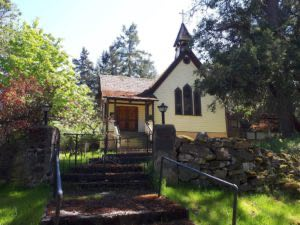
Even though it is the largest of the Gulf Islands, there are a surprising number of churches on Salt Spring Island. The Anglican parish alone has supported six churches over the years, and is currently home to St Mark (1889), St Mary (1894) and All Saints by-the-Sea (1994). Part of the reason for this abundance of churches is that there were very few roads connecting the different settlements on the island up until the 1930s, and the only way to reach those communities was by boat or on horseback.
But as more roads were built, the religious life of the island began to concentrate in the island’s largest village of Ganges and, therefore, at All Saints (formerly St George). During this period, St Mark maintained a dedicated but vital community, with a distinct identity. However, by the early 2000s the congregation had begun to decline due to illnesses, deaths and parishioners moving to All Saints to be part of a larger congregation.
When Gyllian Davies joined the parish as incumbent in 2018, St Mark was hosting services every Tuesday and twice a month on Sunday. The most well-attended was the Tuesday morning centering prayer service, BCP communion and Bible study, which attracted people from a range of denominations and spiritual practices. In winter 2019, St Mark was closed for the winter, in part due to the fact that the church is inaccessible in snowy or icy weather as it sits at the top of a steep road. The plan was to reopen for Easter 2020. But, of course, the COVID-19 pandemic meant that didn’t happen. The parish council reached out to the households that had been associated with St Mark for a meeting; only a handful attended and only one was intending to return to worshipping at the church. Kathy Darling, 94, said, “I feel badly to abandon St Mark’s but I want to be at All Saints where all the people are!” St Mark has remained closed ever since.
Following this long and then sudden decline, at the beginning of 2022, the parish council took the decision to, if possible, sell St Mark.
However, life continues to happen in the parish. During the same period that the congregation at St Mark was reaching the end of its lifecycle, the parish of Salt Spring Island hummed along as a thriving hub for the community.
At the south end of the island, St Mary has hosted the Star of the Sea Centre for Spiritual Living and Practice since 2017. Pre-COVID-19, the All Saints building in Ganges (mid-island) hosted community activities every day of the week, including tai chi, a range of exercise and dance classes, and painting lessons. The church hall also boasts the best acoustics on the island and hosted year-round monthly (weekly in the summer) music concerts, featuring Salt Spring Island musicians. Many of these are about to or have now resumed. The parish also has an agreement with the local emergency services that All Saints will act as a shelter in emergencies.
St Mark has been an important anchor in the life of the island and many on the island have connections to the church going back generations. “I had one couple approach me wanting to be married in St Mark’s,” says Gyllian. “I told them I couldn’t do that because the church building was closed and hadn’t been used in a long time. It turned out the groom’s father and grandfather had both been married at St Mark’s. But once they saw that All Saints was actually a more suitable venue—it has more seating—they were happy to get married there. They just wanted that connection to the island and their family history.
Walter Stewart, a member of the parish and diocesan council, is keen to see as much of the sacred and historic elements of St Mark as possible preserved. “We don’t want to lose the presence of St Mark’s as a pioneering Anglican church. We want to preserve as many items as possible and incorporate them into All Saints.” It is also hoped that the historic church will be renovated as a private residence, so that the building will be lovingly restored and remain a part of the island’s history for decades to come.
“The goal of All Saints is to be a community centre. We want to be a centre of Anglican life, but also to welcome, to provide shelter, to strengthen and nourish the wider community. We also want to be sustainable. All Saints is 28 years old now; it needs new windows and the access ramp is falling apart,” says Gyllian. “Some of the funds from the sale of St Mark’s will go towards making these improvements.”
The decision to close any church is not undertaken lightly nor without heavy hearts. For some this was a painful though obvious decision. As parishioner Dave Phillips said, “Many of the people on Salt Spring think of it as a community treasure and it would be great if it could be set up as a historic heritage building. I sincerely miss the mid-week contemplative services and… I know I’m speaking with my heart and not my head.”
Now that diocesan council and the diocesan finance committee have approved the closing of St Mark the next step will be to plan the deconsecration as a celebration of the life it once housed. Consultations with professionals will inform how some components of St Mark can be incorporated into the All Saints building.
“We look forward to as many decades and more of worship and life at All Saints as were lived out in St Mark’s,” says Gyllian.



